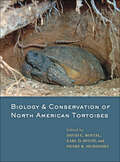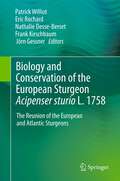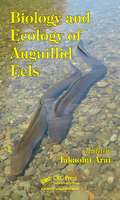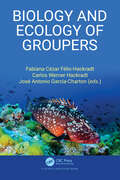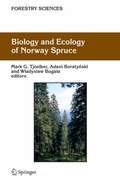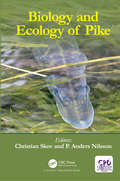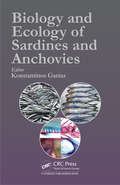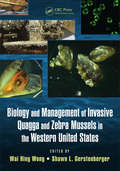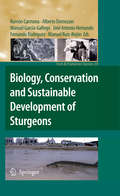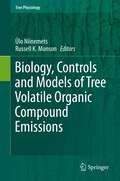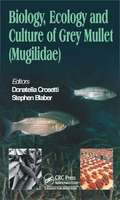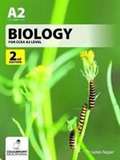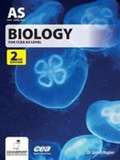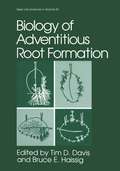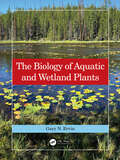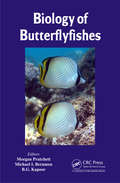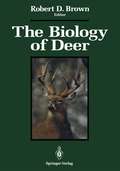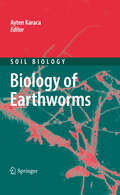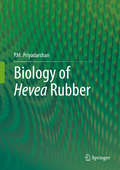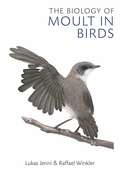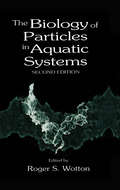- Table View
- List View
Biology and Conservation of North American Tortoises
by David C. Rostal Earl D. McCoy Henry R. MushinskyTortoises, those unmistakable turtles, evolved from a lineage that split off from the familiar pond turtles roughly 100 million years ago. Over time, these plant-eating land turtles spread around the world, growing to an enormous size (depending on the species) and living so long that they have become the stuff of legends. By most accounts, they are indeed the longest-lived of the turtles, with good records suggesting individuals may live as long as 180 years (anecdotal records suggest that some reach ages of 200 years or more).Providing the first comprehensive treatment of North America’s tortoises, Biology and Conservation of North American Tortoises brings together leading experts to give an overview of tortoise morphology, taxonomy, systematics, paleontology, physiology, ecology, behavior, reproduction, diet, growth, health, and conservation. The contributors carefully combine their own expertise and observations with results from studies conducted by hundreds of other researchers. The result is a book that belongs in the library of every herpetologist.ContributorsGustavo Aguirre L.Linda J. AllisonMatthew J. ArescoRoy C. Averill-MurrayJoan E. BerishKristin H. BerryDennis M. BrambleK. Kristina DrakeTaylor EdwardsTodd C. EsqueRichard FranzCraig GuyerJ. Scott HarrisonSharon M. HermannJ. Howard HutchisonElliott R. JacobsonValerie M. JohnsonRichard T. KazmaierEarl D. McCoyPhilip A. MedicaRobert W. MurphyHenry R. Mushinsky Kenneth E. NussearMichael P. O’ConnorThomas A. Radzio David C. RostalLora L. SmithJames R. SpotilaCraig B. StanfordC. Richard TracyTracey D. TubervilleMichael TumaThane Wibbels
Biology and Conservation of the European Sturgeon Acipenser sturio L. 1758: The Reunion of the European and Atlantic Sturgeons
by Patrick Williot, Eric Rochard, Nathalie Desse-Berset, Frank Kirschbaum and Jörn GessnerThe book aims at synthesizing our current knowledge of Acipenser sturio and its management. This species, one of the most widespread sturgeon species all over Western Europe ranging from the Black Sea to the Baltic, is now on the verge of extinction. Major aspects of its biology and management, including mismanagement, are provided in a historic perspective. Similarly, the changes in the restoration programs (in situ and ex situ) initiated in France and Germany are presented. As the species occurred in sympatry with Acipenser oxyrinchus in Germany and Poland and very recently in France as well, a brief outlook on restoration-management programs of A. oxyrinchus are also provided for both North America and Northern European countries, namely Germany and Poland. As conservation-restoration actions go beyond scientific issues, non-governmental stakeholders and marine professional fishermen’s organizations have also been asked to contribute, and the key role of a French-German cooperation plan is underlined. A part of the book is devoted to perspectives. Illustrations of the European sturgeon, mainly in photographs, but also in stamps and paintings, are presented.
Biology and Ecology of Anguillid Eels
by Takaomi AraiAnguillid eels have fascinated biologists for centuries due to their spectacular long-distance migrations between freshwater habitats and their spawning areas far out in the ocean. This book provides a long overdue update on the biology and ecology of anguillid eels and features comprehensive coverage of the key features of the genus Anguilla. It c
Biology and Ecology of Groupers
by Fabiana Cézar Félix-HackradtGroupers are fascinating charismatic fishes commonly found in reef habitats around the world that sustain a global multimillionaire fishery. They are an important top predator species and therefore of paramount ecological importance for reef systems' resilience. The book, Biology and Ecology of Groupers is an up-to-date review of the main bio-ecological topics involving worldwide groupers species oriented to the academic community and managers. It covers aspects of classification and phylogenetic relationships, geographical distribution, and life history related characteristics (Section I), including the major threats of groupers populations, case studies of successful management and comments about the future of groupers in our changing world (Section II).
Biology and Ecology of Groupers
by Fabiana Cézar Félix-Hackradt Carlos Werner Hackradt José Antonio García-ChartonGroupers are fascinating charismatic fishes commonly found in reef habitats around the world that sustain a global multimillionaire fishery. They are an important top predator species and therefore of paramount ecological importance for reef systems' resilience. The book, Biology and Ecology of Groupers is an up-to-date review of the main bio-ecological topics involving worldwide groupers species oriented to the academic community and managers. It covers aspects of classification and phylogenetic relationships, geographical distribution, and life history related characteristics (Section I), including the major threats of groupers populations, case studies of successful management and comments about the future of groupers in our changing world (Section II).
Biology and Ecology of Norway Spruce (Forestry Sciences #78)
by Mark G. Tjoelker Adam Boratynski Wladyslaw BugalaThis is a concise and comprehensive review of the biology, ecology, and management of Norway spruce. Written by 25 experts in the field, and richly illustrated, it integrates classic and contemporary literature. More than 2000 works are cited in the text, which highlights basic research and forestry practices in central and Eastern Europe. The huge range of topics covered includes the species’ morphology, its physiology and nutrition, and its ecology.
Biology and Ecology of Pike
by Anders Nilsson P. Anders NilssonThis book sets out to bridge the order scales among pike researchers, populations, communities, management, and fisheries. It emphasizes the progress of pike research during the last two decades, during which the order-bridging approach emerged. This framework underpins the text and the message, to convey its importance to pike research and to fish research in general. In addition, a considerable part of the book is devoted to management implications and highlights aspects of human dimensions in recreational fisheries.
Biology and Ecology of Pike
by Christian Skov P. Anders NilssonThis book sets out to bridge the order scales among pike researchers, populations, communities, management, and fisheries. It emphasizes the progress of pike research during the last two decades, during which the order-bridging approach emerged. This framework underpins the text and the message, to convey its importance to pike research and to fish research in general. In addition, a considerable part of the book is devoted to management implications and highlights aspects of human dimensions in recreational fisheries.
Biology and Ecology of Sardines and Anchovies
by Konstantinos GaniasApart from being commercially and socially significant, anchovies and sardines populations occupy crucial positions in the oceans' ecosystems. Low in the food chain, clupeoids tend towards abundance, as if their purpose in life was to be eaten and fuel the upper levels of marine trophic chains. The present book covers a broad spectrum of topics on
Biology and Management of Invasive Quagga and Zebra Mussels in the Western United States
by Wai Hing Wong Shawn L. GerstenbergerBiology and Management of Invasive Quagga and Zebra Mussels in the Western United States is a synthesis of the biology and management of invasive mussels from scientists and managers working on invasive quagga and zebra mussels in the western United States. Invasive dreissenid mussels have spread throughout southwestern United States at unprecedent
Biology, Conservation and Sustainable Development of Sturgeons (Fish & Fisheries Series #29)
by Ramón Carmona José Antonio Hernando Fernando Rodríguez Manuel Ruiz-Rejón Alberto Domezain Manuel García GallegoSturgeons are considered “living fossils”, sharing many morphological and biological features with ancestral fish. Furthermore, sturgeons are of the utmost interest from an economic perspective, not only for the caviar but for the flesh. However, the wild populations of the majority of the species are at serious risk of extinction all over the world. So, it is urgent to develop strategies for both farming culture and conservation and recovery in natural habitats. This book provides a comprehensive view of the biology and sustainable development of sturgeons putting emphasis on the Southern Europe autochthonous species such as Acipenser nacarii and Acipenser sturio that share geographical distribution. Other relevant species (such as Huso huso, A. oxyrhinchus, A. ruthenus, A. stellatus) and areas (Germany, Russia, North America) are also considered. The contents are organised in three sections: Taxonomy and Biogeography (including the morphological and genetic analyses that clarify the taxonomy and phylogeny of sturgeons, focused on those from Southern Europe), Biology and Aquaculture (where several aspects of the developmental biology, feeding, and reproduction are considered in relation to the improvement of sturgeon farming), and Recovery and Conservation (that collates and analyses different recovery research actions, the ecology of the rivers for restoration as well as the problems related to the trade of caviar).
Biology, Controls and Models of Tree Volatile Organic Compound Emissions (Tree Physiology #5)
by Ülo Niinemets and Russell K. MonsonPlant-driven volatile organic compound (BVOC) emissions play a major role in atmospheric chemistry, including ozone and photochemical smog formation in the troposphere, and they extend the atmospheric lifetime of the key greenhouse gas, methane. Furthermore, condensation of photo-oxidation products of BVOCs leads to formation of secondary organic aerosols with profound implications for the earth's solar radiation budget and climate. Trees represent the plant life form that most contributes to BVOC emissions, which gives global forests a unique role in regulating atmospheric chemistry.Written by leading experts in the field, the focus is on recent advancements in understanding the controls on plant-driven BVOC emissions, including efforts to quantitatively predict emissions using computer models, particularly on elicitation of emissions under biotic and abiotic stresses, molecular mechanisms of volatile synthesis and emission and the role of emissions in plant stress tolerance.
Biology, Ecology and Culture of Grey Mullets (Mugilidae)
by Donatella Crosetti Stephen J. M. BlaberMullets (grey mullets) are a family (Mugilidae) and order of ray-finned fish found in temperate and tropical waters worldwide. There are approximately 80 species of mullet; these fish have been considered an important food source in Mediterranean Europe since Roman times. This book provides a long overdue update on the biology and ecology of mullet
Biology for CCEA A2 Level (PDF)
by James NapierThis popular resource has been comprehensively updated to cover the revised CCEA A2 level Biology specification. Following the same content as the specification, the book is presented in full colour with over two hundred illustrations. This bright and clear layout will aid students’ understanding of the course. Sample examination questions are also provided throughout to reinforce learning and aid preparation for the exam. New material addressing the practical work in the A2 3 paper has been added to this edition. Contents A2 1 Physiology, Co-ordination and Control, and Ecosystems Chapter 1 – Homeostasis and the Kidney Chapter 2 – Immunity Chapter 3 – Coordination and Control in Plants Chapter 4 – Neurones and Synapses Chapter 5 – The Eye and Muscle Chapter 6 – Populations and Communities Chapter 7 – Ecological Energetics and Nutrient Cycling A2 2 Biochemistry, Genetics and Evolutionary Trends Chapter 8 – Respiration Chapter 9 – Photosynthesis Chapter 10 – DNA as the Genetic Code (Protein Synthesis) Chapter 11 – Gene Technology Chapter 12 – Genes and Patterns of Inheritance Chapter 13 – Population Genetics Chapter 14 – The Plant and Animal Kingdoms Chapter 15 – Statistics The author, Dr James Napier, is a well-known Biology author and a former teacher in a Northern Ireland Grammar School.
Biology for CCEA AS Level (PDF)
by James NapierFully updated for the revised CCEA specification (first teaching September 2016) and endorsed by CCEA. It has been subject to a detailed quality assurance process by an independent Biology expert. It contains new colour-coded practical work sections to address the AS3 paper and provides sample examination questions for each topic. Illustrated in full colour with bright and clear presentation. The author, Dr James Napier, is a well-known Biology author who, prior to his recent retirement, was vice-principal in a Northern Ireland grammar school.
Biology of Adventitious Root Formation (Basic Life Sciences #62)
by Tim D. Davis Bruce E. HaissigCharles E. Hess Department of Environmental Horticulture University of California Davis, CA 95616 Research in the biology of adventitious root formation has a special place in science. It provides an excellent forum in which to pursue fundamental research on the regulation of plant growth and development. At the same time the results of the research have been quickly applied by commercial plant propagators, agronomists, foresters and horticulturists (see the chapter by Kovar and Kuchenbuch, by Ritchie, and by Davies and coworkers in this volume). In an era when there is great interest in speeding technology transfer, the experiences gained in research in adventitious root formation may provide useful examples for other areas of science. Interaction between the fundamental and the applied have been and continue to be facilitated by the establishment, in 1951, of the Plant Propagators' Society, which has evolved into the International Plant Propagators' Society, with active programs in six regions around the world. It is a unique organization which brings together researchers in universities, botanical gardens and arboreta, and commercial plant propagators. In this synergistic environment new knowledge is rapidly transferred and new ideas for fundamental research evolve from the presentations and discussions by experienced plant propagators. In the past 50 years, based on research related to the biology of adventitious root formation, advances in plant propagation have been made on two major fronts.
The Biology of Aquatic and Wetland Plants
by Gary N. ErvinAquatic plants play a critically important role in maintaining ecosystem health. They are natural biological filters in freshwater and estuarine wetlands; they contribute to the reproductive success of many organisms, some of which are harvested for food; they assist in flood control; and they are prominent elements in the aesthetics and recreational use of freshwater and estuarine habitats. Despite this globally recognized importance, wetlands have faced and continue to face threats from the encroachment of human activities. The Biology of Aquatic and Wetland Plants is a thorough and up-to-date textbook devoted to these plants and their interactions with the environment. The focus is on botanical diversity from the perspective of evolutionary relationships, emphasizing the role of evolution in shaping adaptations to the aquatic environment. By incorporating recent findings on the phylogeny of green plants, with special emphasis on the angiosperms, the text is broadly useful for courses in plant biology, physiology, and ecology. Additionally, a chapter on population biology and evolutionary ecology complements the evolutionary backdrop of hydrophyte biology by examining the details of speciation and applications of modern genetic approaches to aquatic plant conservation. Key Features • Synthesizes recent and seminal literature on aquatic and wetland plants • Emphasizes evolutionary history as a factor influencing adaptations to the wetland environment • Provides a global perspective on plant diversity and threats facing wetland ecosystems • Highlights research needs in the field of aquatic and wetland plant biology • Includes 280 figures, with more than 300 color photographs, and 41 tables to provide ease of access to important concepts and information
The Biology of Aquatic and Wetland Plants
by Gary N. ErvinAquatic plants play a critically important role in maintaining ecosystem health. They are natural biological filters in freshwater and estuarine wetlands; they contribute to the reproductive success of many organisms, some of which are harvested for food; they assist in flood control; and they are prominent elements in the aesthetics and recreational use of freshwater and estuarine habitats. Despite this globally recognized importance, wetlands have faced and continue to face threats from the encroachment of human activities. The Biology of Aquatic and Wetland Plants is a thorough and up-to-date textbook devoted to these plants and their interactions with the environment. The focus is on botanical diversity from the perspective of evolutionary relationships, emphasizing the role of evolution in shaping adaptations to the aquatic environment. By incorporating recent findings on the phylogeny of green plants, with special emphasis on the angiosperms, the text is broadly useful for courses in plant biology, physiology, and ecology. Additionally, a chapter on population biology and evolutionary ecology complements the evolutionary backdrop of hydrophyte biology by examining the details of speciation and applications of modern genetic approaches to aquatic plant conservation. Key Features • Synthesizes recent and seminal literature on aquatic and wetland plants • Emphasizes evolutionary history as a factor influencing adaptations to the wetland environment • Provides a global perspective on plant diversity and threats facing wetland ecosystems • Highlights research needs in the field of aquatic and wetland plant biology • Includes 280 figures, with more than 300 color photographs, and 41 tables to provide ease of access to important concepts and information
Biology of Butterflyfishes
by Morgan S. Pratchett Michael L. Berumen B. G. KapoorButterflyfishes (family Chaetodontidae) are a highly conspicuous component of fish fauna on coral reefs throughout the world. In light of their strong dependence on coral, they are often regarded as the epitome of coral reef fishes. This volume examines the ecology and conservation of coral reef butterflyfishes. It provides important insights on th
The Biology of Deer
by Robert D. BrownThe first International Conference on the Biology of Deer Production was held at Dunedin, New Zealand in 1983. That meeting provided, for the first time, a forum for those with interests in either wild deer management or farmed deer production to come together. Scientists, wild deer managers, domestic deer farmers, veterinarians, venison and antler product producers, and others were able to discuss common problems and to share their knowledge and experience. The relationships formed at that meeting, and the information amassed in the resulting Proceedings, sparked new endeavors in cervid research, management, and production. A great deal has taken place in the world of deer biology since 1983. Wild deer populations, although ever increasing in many areas of the world, face new hazards of habitat loss, environmental contamination, and overexploitation. Some species are closer to extinction than ever. Game managers often face political as well as biological challenges. Many more deer are now on farms, leading to greater concerns about disease control and increased needs for husbandry information. Researchers have accumulated considerable new in formation, some of it in areas such as biochemical genetics, not discussed in 1983.
Biology of Earthworms (Soil Biology #24)
by Ayten KaracaEarthworms, which belong to the order Oligochaeta, comprise roughly 3,000 species grouped into five families. Earthworms have been called ‘ecosystem engineers’; much like human engineers, they change the structure of their environments. Earthworms are very versatile and are found in nearly all terrestrial ecosystems. They play an important role in forest and agricultural ecosystems. This Soil Biology volume describes the various facets of earthworms, such as their role in soil improvement, soil structure, and the biocontrol of soil-borne plant fungal diseases. Reviews discuss earthworms’ innate immune system, molecular markers to address various issues of earthworm ecology, earthworm population dynamics, and the influences of organic farming systems and tillage. Further topics include the characteristics of vermicompost, relationships between soil earthworms and enzymes, the role of spermathecae, copulatory behavior, and adjustment of the donated sperm volume.
Biology of Hevea Rubber
by P. M. PriyadarshanIn the second edition of this book, the origin, upkeep and latex harvest from the Hevea rubber tree are dealt with succinctly. New chapters have been included on Propagation Systems and Genetic Resources. The importance of Heterozygosis and Breeding is a new theme for the section on Breeding. A new chapter on Genomics and Molecular Breeding that focuses on the latest advancements on gene mapping, marker assisted selection and stimulation has been added. Lastly, ‘textboxes’ that highlight points and topics of significant interest are included in the new addition.Natural rubber has been an essential commodity not only for the tire industry but also for more than 50,000 products that holds elasticity as an attribute. The prime source of natural rubber worldwide is Hevea brasiliensis. Hevea rubber tree is an excellent example of how a soil-tree-atmosphere system can work in tandem. The retrieval of rubber through ‘injuring’ the tree on alternate days or once in three days or once in seven days, is indeed a unique arrangement followed universally that ensures income to the planter almost throughout the year. Every molecule of rubber is the end result of meticulous biochemical changes. Therefore the biology of Hevea rubber tree itself is a subject that aggregates science and technology for the realization of its industrial utility.
The Biology of Moult in Birds
by Lukas Jenni Raffael WinklerFeathers are amazing structures unique to birds and, for a variety of reasons, they need to be renewed periodically as a whole in a process called moult. During this process, all of the functions of plumage are impaired and most aspects of a bird's life are affected. Every moult determines a bird's appearance anew, and restores plumage efficacy for flight and insulation. Moult profoundly affects physiology and the organization of the annual cycle, and it constrains reproduction and migration. Given these major impacts, which are equal to the other annual challenges of reproduction and migration, it is surprising that research on moult has largely been so neglected a subject. Lukas Jenni and Raffael Winkler have brought together the widely scattered results of studies on the processes and consequences of moult in birds. This book opens with an overview of the functions of plumage, and of feather maintenance and feather wear, and then introduces the two functions of moult: replacement of worn feathers and adjustment of plumage characteristics and appearance. The body of the book then examines feather-growth and the physiology, energetics and control of moult, and how various other physiological processes interact with moult and may compensate for its costs. Significantly, the authors explain how variations in moult and feather quality affect a bird's overall plumage quality, and they highlight the resulting consequences in terms of physical performance, appearance and signalling. Finally, there is a review of all the various solutions that birds have developed to fit moult into the annual cycle.This long-awaited book covers for the first time all aspects of the biology of moult and fills an important gap in the literature, completing our understanding of how the most important annual events in a bird's life fit together into a coherent whole. It draws on a wide range of information – from penguins to small passerines, from raptors to wildfowl – to highlight the variety of the subject and to pinpoint the many gaps in our knowledge along with avenues for fruitful further research.
The Biology of Moult in Birds
by Lukas Jenni Raffael WinklerFeathers are amazing structures unique to birds and, for a variety of reasons, they need to be renewed periodically as a whole in a process called moult. During this process, all of the functions of plumage are impaired and most aspects of a bird's life are affected. Every moult determines a bird's appearance anew, and restores plumage efficacy for flight and insulation. Moult profoundly affects physiology and the organization of the annual cycle, and it constrains reproduction and migration. Given these major impacts, which are equal to the other annual challenges of reproduction and migration, it is surprising that research on moult has largely been so neglected a subject. Lukas Jenni and Raffael Winkler have brought together the widely scattered results of studies on the processes and consequences of moult in birds. This book opens with an overview of the functions of plumage, and of feather maintenance and feather wear, and then introduces the two functions of moult: replacement of worn feathers and adjustment of plumage characteristics and appearance. The body of the book then examines feather-growth and the physiology, energetics and control of moult, and how various other physiological processes interact with moult and may compensate for its costs. Significantly, the authors explain how variations in moult and feather quality affect a bird's overall plumage quality, and they highlight the resulting consequences in terms of physical performance, appearance and signalling. Finally, there is a review of all the various solutions that birds have developed to fit moult into the annual cycle.This long-awaited book covers for the first time all aspects of the biology of moult and fills an important gap in the literature, completing our understanding of how the most important annual events in a bird's life fit together into a coherent whole. It draws on a wide range of information – from penguins to small passerines, from raptors to wildfowl – to highlight the variety of the subject and to pinpoint the many gaps in our knowledge along with avenues for fruitful further research.
The Biology of Particles in Aquatic Systems, Second Edition
by Roger S. WottonThe Biology of Particles in Aquatic Systems, Second Edition presents the latest information on particulate and dissolved matter found in aquatic habitats ranging from small streams to oceans. Only by studying this matter can we gain an understanding of the functioning of aquatic ecosystems and thus be able to predict changes that may occur as these systems become stressed. Updated and extensively revised, this new edition covers such topics as classification of particulate and dissolved matter, origin and formation of particles aquatic systems, factors affecting particle aggregation, methods for capturing particles by benthic and planktonic animals, and the use of particulate and dissolved organic matter as food.
